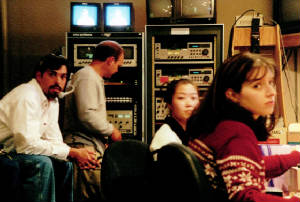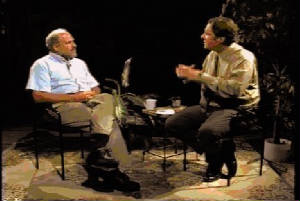|
PCT's thirty-two channel Mackie audio console ensures that your program sounds great.


|
| Crews are almost all volunteer |
The excitement about television generated by the 1939 World's Fair carried the interest in television through WWII when development of the medium took a back seat. By the time the war was
over the electronic system of television had clearly proven its greater capacity and a period of intense growth took place.
Between 1945 and 1948 the number of commercial (as opposed to experimental) television stations grew from 9 to 48 and the
number of cities having commercial service went from 8 to 23. And, sales of television sets increased 500%. By 1960 there
were 440 commercial VHF stations, 75 UHF stations, and 85% of U.S. households had a television set. www.fcc.gov
|
 |

|
| Above is a "Your Hired" show taping in progress |
PCT facilities include:
- 3-camera production studio for live or "live-to-tape" productions
- Final Cut Pro/iMovie edit suite
- Avid Xpress edit suite
- Sony PD150 and PD X10 remote camera packs (staff only)
- Sony handi-cam Hi-8 remote camera packs
- Lowell Portable lighting packs
 

|
| PCT remote TV studio at the annual Fog Fest |
|
 |
 |
|
In 1946 Peter Goldmark, working for CBS, demonstrated his color television system to the FCC. His system produced color pictures by having a red-blue-green wheel spin in front of a cathode ray tube. This
mechanical means of producing a color picture was used in 1949 to broadcast medical procedures from Pennsylvania and Atlantic
City hospitals.
In Atlantic City, viewers could come to the convention center to see broadcasts of operations. Reports from the time
noted that the realism of seeing surgery in color caused more than a few viewers to faint. Although Goldmark's mechanical
system was eventually replaced by an electronic system he is recognized as the 1st to introduce a color television system.

|
| PCT Volunteers tape a show in our facility |
|
|
 |
 |
 |
|

Production Supervisor Wayne Hess oversees a show above.
In 1945 the 1st experimiental microwave relay system was introduced by Western Union between New York and Philadelphia. This distribution system transmitted communication signals
via radio along a series of towers. With lower costs than coaxial cable, microwave relay stations carried most TV traffic
by the 1970’s.
In 1948 there were early tests of cable television in the rural area of Lansford, PA. This and other early cable systems primarily provided improved reception of broadcast
programming from nearby large cities. Thus, cable television was basically a redelivery system until the late 1960’s. www.fcc.gov
|
|

